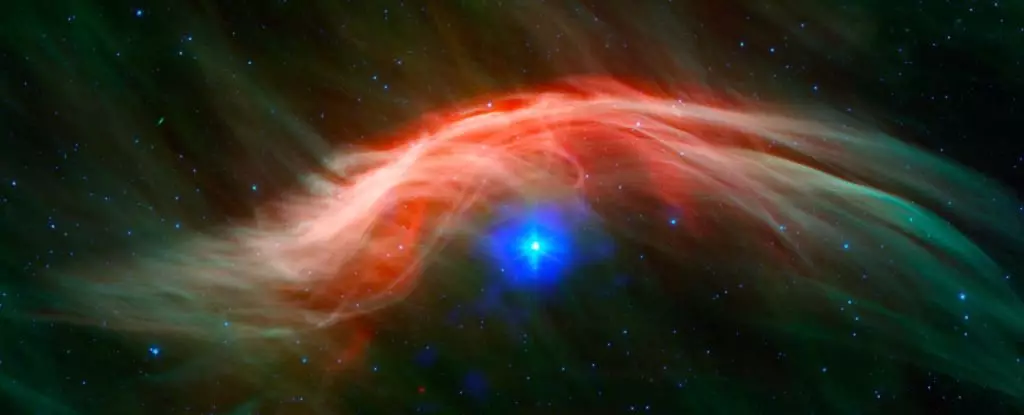The universe is a vast, dynamic expanse, often perceived as detached from the everyday happenings on our blue planet. However, emerging research suggests that cosmic events can profoundly influence terrestrial evolution in unexpected ways. A recent study led by astrophysicist Caitlyn Nojiri from the University of California, Santa Cruz, takes us into the depths of Lake Tanganyika in eastern Africa, correlating a significant diversification of viral life in the lake with cosmic radiation from a supernova that occurred approximately 2.5 million years ago. This revelation prompts an inquiry into how celestial happenings could shape biological responses on Earth, particularly regarding evolution.
Our Solar System resides in an area known as the Local Bubble, a bubble-shaped region through which our solar neighborhood moves, largely devoid of neighboring stars. This bubble has its origins in a succession of historical supernovae that have dramatically altered the interstellar medium. As these powerful explosions send shockwaves through space, they can elevate radiation levels on Earth to significant extents, raising pertinent questions about the implications of such activity. Notably, radiation is recognized for its role as a mutagen, inciting genetic variation—an essential component of evolutionary mechanics.
The intriguing interplay between space and life forms on Earth invites us to contemplate the long-reaching effects of supernovae. Nojiri and her team’s exploration into deep-sea sediment core samples highlights an isotope of iron called iron-60, a telltale marker of supernova activity. This isotope accumulates in Earth’s stratigraphy when remnants of supernovae drift through local space, cascading down to enrich our planet’s geological record.
In prior research, physicists identified two prominent spikes in iron-60 within seabed sediments, dated to specific epochs—one circa 6.5 to 8.7 million years ago and the other between 1.5 to 3.2 million years ago. The focus of Nojiri’s research is the latter spike, which likely coincided with a nearby supernova in the Scorpius-Centaurus or Tucana-Horologium star groups. Not only did they substantiate the correlation between these spikes and cosmic explosions, but their simulations also proposed a severe bombardment of cosmic radiation for approximately 100,000 years following the explosion. Such an ongoing radiation influx could have formed new environmental pressures on ecosystems, catalyzing evolutionary trends.
The environment of Lake Tanganyika serves as a fascinating case study in this context. Home to a unique assemblage of organisms, the lake’s viral populations saw a marked increase in diversity around the same timeframe as the proposed cosmic event—between 2 and 3 million years ago. Though it is important to highlight the lack of conclusive causation between the two phenomena, the temporal relationship offers fertile ground for hypotheses regarding cosmic rays’ potential roles in driving biological changes.
Radiation’s Role as a Driver of Evolution
The implications of increased radiation in altering life forms extend beyond merely introducing mutations; they offer a broader lens through which to examine evolutionary pathways. For instance, research indicates that elevated radiation levels can disturb DNA, engendering mutations that might lead to new adaptations. Given that the radiation levels hypothesized to result from the nearby supernova could significantly exceed natural background radiation, they represent an accelerant for evolutionary processes.
Nojiri’s findings augment the narrative that significant cosmic events might influence Earth’s biosphere in ways previously underestimated. In particular, studies have hinted at the radiation threshold required to elicit biological changes. The elucidation of this relationship challenges traditional paradigms that regard evolution as a slow, isolated process and suggests a more interconnected universe where distant explosions echo through terrestrial ecosystems.
The exploration of the relationship between cosmic events and terrestrial evolution inevitably leads to deeper reflections on our place in the cosmos. While it is true that evolution is driven by myriad factors—environmental pressures, genetic variation, and survival mechanisms—Nojiri’s research posits that we should recognize the profound implications of cosmic phenomena. It serves as a reminder of the interconnectedness of existence; we are not merely inhabitants of Earth but also participants in a broader cosmic narrative where the fates of stars and life on our planet collide spectacularly.
Thus, while we may sometimes view ourselves as isolated in the void of space, the reality demonstrates that distant celestial events can shape our biological landscape in subtle and dramatic ways, pushing us to ponder our identity as earthlings amidst the stardust of the universe. As Carl Sagan famously remarked, we are indeed stardust—the cosmic tapestry weaves our stories together, urging us to understand our evolution within the grander scale of the cosmos.


Leave a Reply